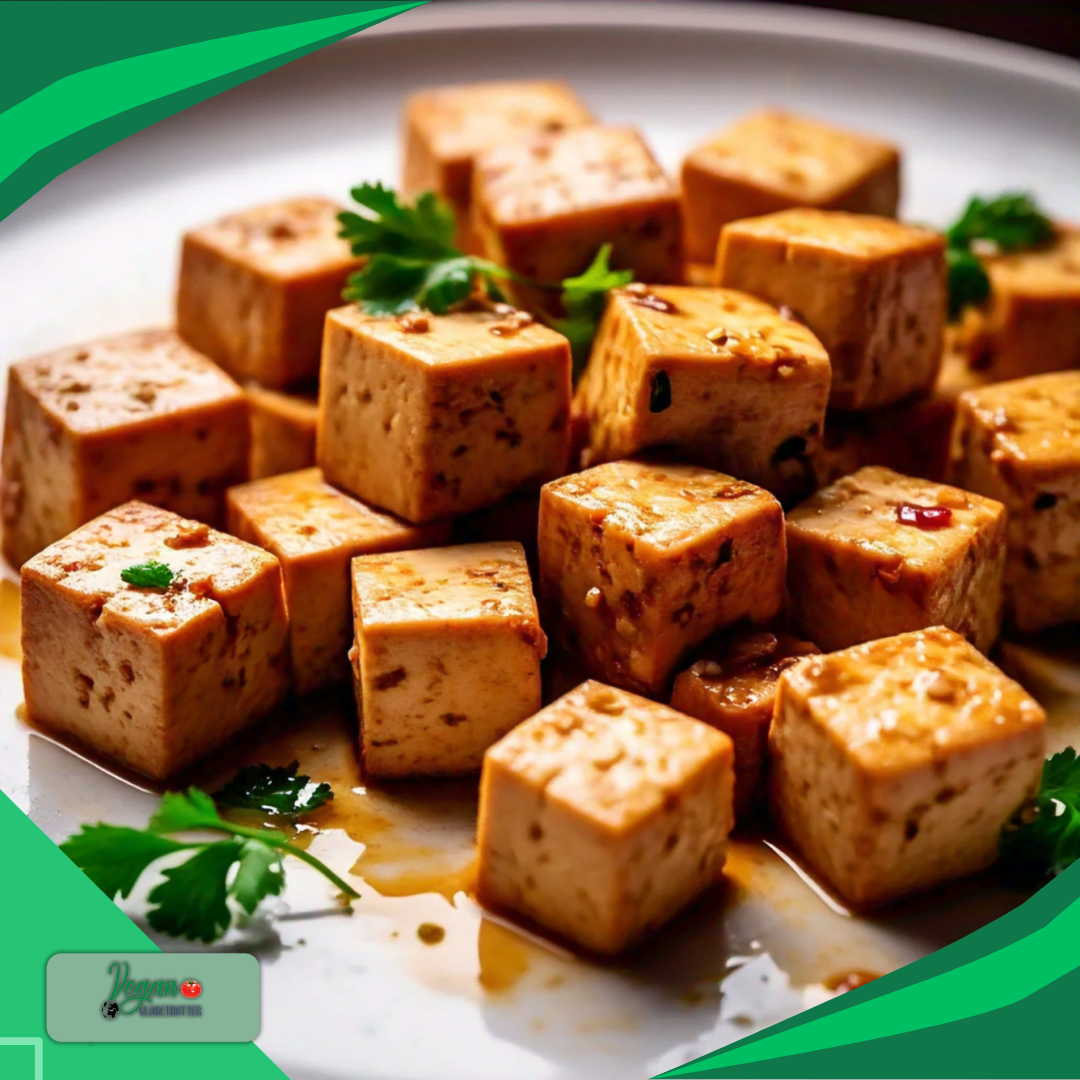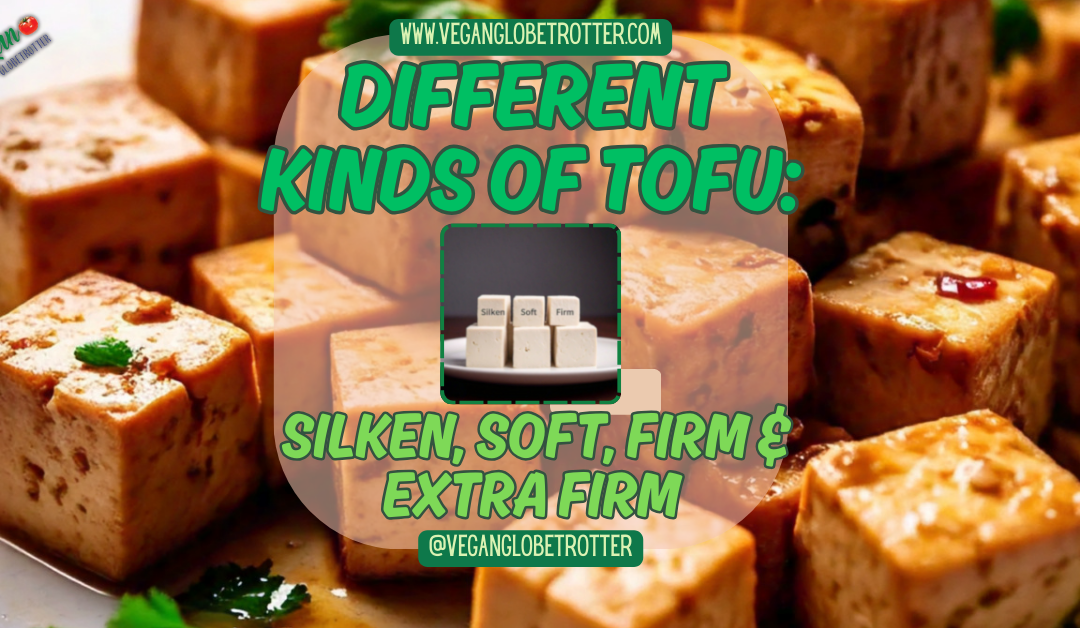Vegan Globetrotter is supported by our audience. When you purchase through one of our links, we may earn a small affiliate commission. As an Amazon Associate I earn from qualifying purchases. Your cost is not affected.
==================
Different kinds of tofu, I’ve learned, are far more than just one homogenous block. Once, I naively believed tofu was a singular entity, but the culinary world has unveiled its diverse forms, each offering unique textures and flavors. This revelation has opened up a world of possibilities, and I’m excited to share it with you. From the delicate silken tofu to the firm, sturdy extra-firm variety, these different kinds of tofu are invaluable assets in the kitchen. Let’s dive into the wonderful world of tofu and discover how to best utilize these culinary treasures.
Different Kinds of Tofu: A Comprehensive Guide
Tofu is a versatile food that comes in many forms. You might have seen different types at the store and wondered how to use them. The main kinds are silken, soft, firm, and extra firm. Each type of tofu has its own texture and best uses in cooking.

Silken tofu is smooth and delicate. It’s great for blending into sauces or desserts. Soft tofu is a bit firmer and works well in soups. Firm and extra firm tofu can be pressed and fried for a crispy outside. You can use them in stir-fries or as a meat substitute in many dishes.
Trying different types of tofu can open up new cooking ideas for you. Whether you’re vegan, vegetarian, or just want to eat more plant-based meals, tofu is a good choice. It soaks up flavors well and can be cooked in many ways.

Key Takeaways
- Tofu comes in silken, soft, firm, and extra firm types for different uses
- Firmer tofu can be pressed and fried, while softer types work in blended dishes
- Tofu is a flexible ingredient for many diets and cooking styles
The Basics of Tofu

Tofu, also known as bean curd, is a versatile food made from soybeans. It’s a staple in many Asian cuisines and has gained popularity worldwide.
To make tofu, producers start with soy milk. They add a coagulant to turn the milk into curds. These curds are then pressed into blocks.
You might wonder about the different types of tofu. There are four main kinds:
- Silken
- Soft
- Firm
- Extra firm
Each type has its own texture and best uses. Silken tofu is creamy and custard-like, perfect for smoothies and desserts.
Soft tofu is a bit firmer but still delicate. It’s great in soups and stews.
Firm and extra firm tofu hold their shape well. You can stir-fry, grill, or bake these types.
When you’re shopping, you’ll find tofu in the refrigerated section. It often comes packed in water to keep it fresh.
Before cooking, you might want to press your tofu. This removes extra water and helps it absorb flavors better.
Tofu is packed with protein and low in calories. It’s a great option if you’re looking to eat less meat or follow a plant-based diet.
Bet You Didn't Know:
Tofu can mimic a variety of textures, from the soft, creamy texture of ricotta cheese to the firm, meaty texture of steak. By adjusting the firmness of the tofu and the cooking method, you can create a wide range of dishes, making it a truly versatile ingredient in any kitchen.

Silken Tofu

Silken tofu is a soft, delicate type of tofu with a smooth texture. You’ll find it useful for many recipes, from soups to desserts.
Characteristics of Silken Tofu
Silken tofu has a creamy, custard-like consistency. It’s very fragile and breaks easily. You’ll notice it has a higher water content than other tofu types.
This tofu comes in soft, medium, firm, and extra-firm varieties. But don’t worry too much about these differences. For most recipes, you can use any of these interchangeably.
Silken tofu is usually sold in aseptic packages that don’t need refrigeration. This makes it easy to keep in your pantry for when you need it.

Common Uses of Silken Tofu
You’ll love how versatile silken tofu is in the kitchen. It’s perfect for blending into smooth, creamy dishes.
Try using it in:
- Miso soup
- Salad dressings
- Vegan mayo
- Tofu desserts like puddings or pies
Silken tofu works great as an egg substitute in baking. Use 1/4 cup of blended silken tofu to replace one egg in your recipes.
It’s also fantastic in smoothies. Add it for extra protein and a creamy texture without changing the flavor much.
Soft Tofu

Soft tofu has a delicate texture and mild flavor. You can use it in many dishes, from savory to sweet. It’s a versatile ingredient that adds a silky smoothness to your meals.
Characteristics of Soft Tofu
Soft tofu feels tender and falls apart easily. It has a high water content, making it jiggly and smooth. You’ll find it’s less firm than medium or firm tofu, but not as silky as silken tofu.
This type of tofu is great for soaking up flavors. It works well in soups and stews because it won’t break apart completely. You can also blend it into smoothies or use it as an egg substitute in baking.
Soft tofu is packed with protein and low in calories. It’s a healthy choice for many diets. You can find it in most grocery stores, usually packed in water to keep it fresh.

Common Dishes with Soft Tofu
Mapo tofu is a popular Chinese dish that uses soft tofu. The tofu cubes are gently cooked in a spicy sauce with ground meat. The soft texture soaks up the flavors beautifully.
You can use soft tofu in Korean tofu stew (sundubu-jjigae). This spicy, comforting dish lets the tofu shine. The gentle heat of the stew keeps the tofu intact while warming you up.
For a simple snack, try cold soft tofu with a drizzle of soy sauce and green onions. This dish, known as hiyayakko in Japan, is refreshing and easy to make.
Soft tofu also works well in desserts. You can blend it into puddings or mousses for a creamy texture. It’s a great way to add protein to your sweet treats without changing the flavor much.
Medium and Medium-Firm Tofu

Medium and medium-firm tofu offer a balance between softness and firmness. They’re great for many recipes and cooking methods.
Characteristics of Medium Tofu
Medium tofu has a soft, slightly spongy texture. It’s firmer than silken tofu but still delicate. You can use it in soups, like miso soup, or serve it cold in dishes.
When you cut medium tofu, it holds its shape but can break if handled roughly. It absorbs flavors well, making it perfect for marinades. You can also use it in smoothies or desserts for a creamy texture.
Medium tofu works well in:
- Stir-fries (cut into large cubes)
- Soups
- Cold dishes
- Desserts

Characteristics of Medium-Firm Tofu
Medium-firm tofu is a bit denser than medium tofu. It’s great for dishes where you want the tofu to keep its shape but still be tender.
You can press medium-firm tofu to remove extra water. This makes it firmer and helps it absorb more flavor. It’s perfect for grilling or pan-frying.
Medium-firm tofu is good for:
- Baking
- Grilling
- Pan-frying
- Scrambles
You might also find tofu puffs, which are made from medium or medium-firm tofu. These are deep-fried and have a spongy texture. They’re great in soups or stir-fries.
Firm and Extra-Firm Tofu

Firm and extra-firm tofu are dense varieties that hold their shape well. They’re great for cooking methods that require tofu to keep its structure.
Characteristics of Firm Tofu
Firm tofu has a solid texture but still retains some moisture. You can press firm tofu to remove excess water. This makes it even denser and helps it absorb marinades better.
Here’s what you need to know about firm tofu:
• Texture: Slightly spongy but holds its shape
• Best for: Stir-fries, grilling, baking
• Pressing time: 15-30 minutes
Firm tofu is versatile. You can cube it for stir-fries or slice it for sandwiches. It’s sturdy enough to stand up to high-heat cooking methods like grilling or pan-frying.

Characteristics of Extra-Firm Tofu
Extra-firm tofu is the densest type of block tofu. It has very little water content and a chewy texture. You don’t always need to press it, but doing so can make it even firmer.
Key points about extra-firm tofu:
• Texture: Very dense and chewy
• Best for: Grilling, baking, frying
• Pressing time: 0-15 minutes (optional)
This type of tofu is perfect when you want a “meatier” texture. It’s great for creating crispy baked tofu or adding to hearty stews. Extra-firm tofu holds up well to bold flavors and sauces.
Creative Tofu Preparations

Tofu is a versatile ingredient that can be prepared in many tasty ways. You can transform this humble soy product into delicious dishes with a few simple techniques.
Marinating Tofu
Marinating tofu is a great way to add flavor. Start by pressing your tofu to remove excess water. This helps it soak up more marinade.
Cut the tofu into cubes or slices. Place it in a shallow dish. Pour your favorite marinade over it. Try soy sauce, garlic, and ginger for an Asian flair. Or use herbs and lemon for a Mediterranean taste.
Let the tofu soak for at least 30 minutes. For best results, marinate it overnight in the fridge. The longer it soaks, the more flavor it will absorb.
After marinating, you can grill, bake, or pan-fry your tofu. It will be packed with flavor and ready to add to any dish.
Frying and Baking Tofu
Crispy tofu is a treat that’s easy to make at home. For frying, cut firm or extra-firm tofu into cubes. Coat them in cornstarch. Heat oil in a pan and fry until golden brown.
Baking is a healthier option. Preheat your oven to 400°F. Cut the tofu into slices or cubes. Toss with oil and seasonings. Spread on a baking sheet. Bake for 25-30 minutes, flipping halfway through.
Both methods give you crispy tofu that’s perfect for stir-fries, salads, or snacking. Try adding your favorite spices or sauces for extra flavor.
Tofu as a Substitute
Tofu can replace many animal products in recipes. It’s great for making vegan versions of classic dishes.
For a tofu scramble, crumble firm tofu and cook it with turmeric, nutritional yeast, and veggies. It’s a tasty egg-free breakfast option.
Silken tofu works well as an egg substitute in baking. Blend it until smooth and use it in cakes or cookies.
You can also make vegan ricotta with firm tofu. Crumble it and mix with lemon juice, nutritional yeast, and herbs. Use it in lasagna or as a spread.
With these creative methods, you can enjoy tofu in many delicious ways. It’s a flexible ingredient that fits into all kinds of cuisines and diets.
Tofu in World Cuisines

Tofu has found its way into many global dishes. It’s used in both traditional Asian recipes and modern Western cooking.
Tofu in Asian Cuisine
In Asian cooking, tofu is a star. You’ll find it in many Chinese-style dishes. Soft tofu works great in soups and stews. Firm tofu is perfect for stir-fries.
Try deep-fried tofu for a crispy treat. It soaks up flavors well, making it great with marinades. Garlic and soy sauce are common seasonings for tofu dishes.
In Japan, you might enjoy hiyayakko, a chilled tofu dish. Korea has its famous soon dubu jjigae, a spicy tofu stew. Southeast Asian cuisines often use tofu in curries and noodle dishes.
Tofu in Western Dishes
You can use tofu in many Western recipes too. It’s a great egg substitute in breakfast scrambles. Crumbled firm tofu works well as a meat replacement in tacos or pasta sauces.
Tofu can make creamy dressings and dips. Blend silken tofu for a smooth texture in desserts like puddings or cheesecakes. You can even grill tofu for a tasty addition to salads or sandwiches.
Many people enjoy tofu as a protein boost in smoothies. It adds a creamy texture without changing the flavor much. You can also bake tofu for a crunchy snack or use it in veggie burgers.
Pairing Tofu with Ingredients

Tofu is a blank canvas that soaks up flavors. You can pair it with many tasty sauces and ingredients to make delicious meals.
Complementary Sauces for Tofu
Soy sauce is a classic choice for tofu. It adds a salty, umami flavor that tofu loves. Try mixing soy sauce with garlic and ginger for an easy marinade.
For a creamy option, vegan mayo works great. You can use it as a base for dips or spreads. Mix in some herbs or spices to give it extra zip.
Salad dressings are perfect for tofu too. Italian, ranch, or sesame ginger can add lots of flavor. You can use them as marinades or drizzle them on top of cooked tofu.
Don’t forget about sweet sauces! Teriyaki or sweet chili sauce can turn plain tofu into a tasty treat. They work well for stir-fries or as dipping sauces.
Embracing Tofu: A Culinary Journey
Thank you for taking the time to explore the fascinating world of tofu with me. We’ve journeyed through the various types of tofu, from the silken smoothness to the firm, versatile extra-firm. We’ve discussed their unique qualities and how they can be incorporated into diverse culinary creations.

I hope this exploration has ignited your curiosity and inspired you to experiment with tofu in your own kitchen. Whether you’re a seasoned cook or a novice, tofu offers endless possibilities. It’s a nutritious, versatile ingredient that can be enjoyed in countless ways.
So, let’s celebrate tofu, this culinary chameleon, and embrace the diversity it brings to our plates. Happy cooking!

Frequently Asked Questions

Tofu comes in various types, each with unique properties and uses. Different kinds of tofu require specific storage methods to stay fresh.
What are the distinct types of tofu and their best culinary uses?
Tofu comes in several types. Silken tofu works great in smoothies and desserts. Soft tofu is perfect for soups and dips.
Firm tofu is good for stir-fries and grilling. Extra-firm tofu holds up well in sandwiches and salads.
How can one differentiate between silken, soft, firm, and extra-firm tofu?
You can tell tofu types apart by their texture. Silken tofu is very delicate and breaks easily. Soft tofu is a bit firmer but still fragile.
Firm tofu holds its shape when pressed. Extra-firm tofu is the most solid and can be easily sliced or cubed.
Can you substitute firm tofu for silken tofu in recipes?
You can’t always swap firm tofu for silken tofu. Silken tofu is much smoother and has more water. It works better in creamy dishes.
Firm tofu has less water and a chewier texture. It’s better for recipes that need tofu to hold its shape.
What are the key differences between super firm and extra firm tofu?
Super firm tofu has even less water than extra firm tofu. It’s the densest type of tofu available.
Extra firm tofu still has some moisture. Super firm tofu is best for grilling or when you need tofu to keep a very firm shape.
What type of tofu is ideal for traditional Korean dishes?
For Korean dishes, soft or medium tofu is often used. It’s perfect for soups like sundubu-jjigae (soft tofu stew).
Firm tofu works well in stir-fries and for pan-frying in dishes like dubu-jorim (braised tofu).
How should different kinds of tofu be stored to maintain freshness?
Keep unopened tofu in the fridge until the expiration date. Once opened, store tofu in water in an airtight container.
Change the water daily to keep it fresh. Use opened tofu within 3-5 days for the best quality and taste.
Deepen Your Vegan Journey with Us!
Craving more plant-powered inspiration? Join our vibrant vegan community across social media!
- Facebook: Vegan Globetrotter
- Instagram: @veganglobetrotter
- Pinterest: The Vegan Globetrotter
- Twitter: @VeganGlobetrot
- YouTube: Vegan Globetrotter
Discover delicious recipes, honest product reviews, travel tips, and connect with fellow vegans on their journey!



Don't miss out
when new recipes and information are added!
Join our newsletter for free recipes,
healthy living inspiration, and special offers
You have Successfully Subscribed!